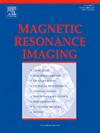Ki-67表达与子宫内膜癌中一种新型灌注MRI生物标志物扩散衍生血管密度(DDVD)之间的高度相关性
IF 2.1
4区 医学
Q2 RADIOLOGY, NUCLEAR MEDICINE & MEDICAL IMAGING
引用次数: 0
摘要
目的:探讨扩散源性血管密度(diffusion derived vessel density, DDVD)在子宫内膜癌(endomecarcinoma, EC)中表征肿瘤微血管的可行性,并探讨基于DDVD值与Ki-67增殖状态及组织学分型的相关性。方法:81例EC患者。非侵袭性组织型64例,侵袭性组织型17例。Ki-67标记指数低((b0b20)按DDVD(b0b20) = Sb0/ROIarea0 - Sb20/ROIarea20计算,其中Sb0和Sb20为b为0或20 s/mm2时的组织信号。类内相关系数(ICC);采用双尾独立样本t检验、Mann-Whitney U检验和曲线下接收者工作特征面积(Receiver operating characteristic area under curve, AUC)进行统计分析。结果:子宫内膜癌的DDVD(b0b20)值(34.9±21.2,au/pixel)低于肌层(65.3±37.4),P (b0b20) ROC曲线分析显示Ki-67低表达与高表达的AUC为0.842,非侵袭性与侵袭性组织学类型的AUC为0.771。DDVD(b0b20) > 32.9和DDVD(b0b20) > 50.1分别为Ki67高表达(敏感性78.3%)和组织侵袭型(敏感性47.1%)提供了85%的特异性。结论:DDVD可作为反映EC Ki-67增殖和组织学侵袭性的影像学标志物,有助于EC预处理风险评估。本文章由计算机程序翻译,如有差异,请以英文原文为准。
High correlation between Ki-67 expression and a novel perfusion MRI biomarker diffusion-derived vessel density (DDVD) in endometrial carcinoma
Objective
This study aimed to investigate the feasibility of diffusion-derived vessel density (DDVD) in characterizing tumor microvasculature in endometrial carcinoma (EC), and to explore the correlations with Ki-67 proliferation status and histological type based on DDVD values.
Methods
There were in total 81 EC patients. There were 64 cases of non-aggressive histological type, and 17 cases of aggressive histological type. Ki-67 labeling index was low (<50 %) in 35 cases and high (≥50 %) in 46 cases. DDVD(b0b20) is calculated according to: DDVD(b0b20) = Sb0/ROIarea0 – Sb20/ROIarea20, where Sb0 and Sb20 refer to the tissue signal when b is 0 or 20 s/mm2. Intraclass correlation coefficient (ICC); two-tailed independent samples t-test and Mann-Whitney U test, and Receiver operating characteristic area under the curve (AUC) were applied for statistical analysis.
Results
Endometrial carcinoma showed lower DDVD(b0b20) values (34.9 ± 21.2, au/pixel) compared with myometrium (65.3 ± 37.4, P < 0.001). Tumors with Ki-67 high-proliferation or aggressive histological type had higher DDVD values than those with Ki-67 low-proliferation (44.17 (median) vs. 16.08, P < 0.001]] or non-aggressive histological type (47.92 vs. 30.77, P = 0.002). DDVD(b0b20) ROC curve analysis shows AUC of 0.842 for distinguishing between Ki-67 low- and high-expression, and AUC of 0.771 for distinguishing between non-aggressive and aggressive histological types. DDVD(b0b20) > 32.9 and DDVD(b0b20) > 50.1 provided a specificity of 85 % for identifying Ki67 high expression (sensitivity 78.3 %) and histological aggressive type (sensitivity 47.1 %), respectively.
Conclusion
DDVD can act as an imaging marker reflecting Ki-67 proliferation and histological aggressiveness of EC, thus helping pretreatment risk assessment in EC.
求助全文
通过发布文献求助,成功后即可免费获取论文全文。
去求助
来源期刊

Magnetic resonance imaging
医学-核医学
CiteScore
4.70
自引率
4.00%
发文量
194
审稿时长
83 days
期刊介绍:
Magnetic Resonance Imaging (MRI) is the first international multidisciplinary journal encompassing physical, life, and clinical science investigations as they relate to the development and use of magnetic resonance imaging. MRI is dedicated to both basic research, technological innovation and applications, providing a single forum for communication among radiologists, physicists, chemists, biochemists, biologists, engineers, internists, pathologists, physiologists, computer scientists, and mathematicians.
 求助内容:
求助内容: 应助结果提醒方式:
应助结果提醒方式:


